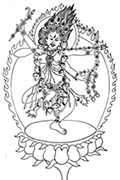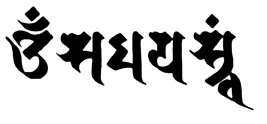 I've added a new page for the first time in a while. This one is for the Tantric figure Kurukullā, who is associated with the Red Rite, or the Rite of Fascination. She resembles a ḍakiṇī in form and is distinguished by the fact that she is drawing back a bow with an arrow fitted - both of which are covered in flowers.
I've added a new page for the first time in a while. This one is for the Tantric figure Kurukullā, who is associated with the Red Rite, or the Rite of Fascination. She resembles a ḍakiṇī in form and is distinguished by the fact that she is drawing back a bow with an arrow fitted - both of which are covered in flowers.
15 February 2009
Kurukullā
 I've added a new page for the first time in a while. This one is for the Tantric figure Kurukullā, who is associated with the Red Rite, or the Rite of Fascination. She resembles a ḍakiṇī in form and is distinguished by the fact that she is drawing back a bow with an arrow fitted - both of which are covered in flowers.
I've added a new page for the first time in a while. This one is for the Tantric figure Kurukullā, who is associated with the Red Rite, or the Rite of Fascination. She resembles a ḍakiṇī in form and is distinguished by the fact that she is drawing back a bow with an arrow fitted - both of which are covered in flowers.
Labels:
updates
08 February 2009
A couple of stray mantras
Of the thirteen principle Buddhas and Bodhisattvas of the Shingon school I have pages for eleven. The two that are missing are Mahāsthāmaprāpta and Samantabhadra, neither of whom have the same popularity (at least in these forms) in the West as they do in Japan. In some schools of Tibetan Buddhism Samantabhadra becomes the Adibuddha, that is he takes Mahāvairocana's role.
In anycase until I get around to creating pages for these two, here are their mantras in siddhaṃ with Roman, Devanāgarī, and, as an experiment, Tibetan (note the Tibetan is Unicode but you might need to find a Tibetan font as the Tibetan range isn't often included in standard fonts. I use Tibetan Machine Uni)
Mahāsthāmaprāpta (Seishi Bosatsu) महास्थामप्राप्त

oṃ saṃ jaṃ jaṃ saḥ svāhā
ओं सं जं जं सः स्वाहा
ཨོཾ་སཾ་ཇཾ་ཇཾ་སཿ་སྭཱ༌ཧཱ།
Note: Her bīja is saḥ सः སཿ
Samantabhadra (Fugen Bosatsu) समन्तभद्र

oṃ sa ma ya stvaṃ i.e. oṃ samayas tvaṃ
ओं समयस्त्वं
ཨོཾ་ས་མ་ཡ་སྠྭཾ།
Note:
samaya is an agreement or contract, the nominative singular is samayaḥ which changes to samayas when followed by the t of tvaṃ meaning you, also nom. sg. So that part means "you are bound", or "there is an agreement or contract with you". It probably refers to the tantric vows one takes before abhiṣeka.
Samantabhadra's bīja is aṃ अं ཨཾ
Do let me know how the Tibetan looks as I want to start using it more extensively.
In anycase until I get around to creating pages for these two, here are their mantras in siddhaṃ with Roman, Devanāgarī, and, as an experiment, Tibetan (note the Tibetan is Unicode but you might need to find a Tibetan font as the Tibetan range isn't often included in standard fonts. I use Tibetan Machine Uni)
Mahāsthāmaprāpta (Seishi Bosatsu) महास्थामप्राप्त

oṃ saṃ jaṃ jaṃ saḥ svāhā
ओं सं जं जं सः स्वाहा
ཨོཾ་སཾ་ཇཾ་ཇཾ་སཿ་སྭཱ༌ཧཱ།
Note: Her bīja is saḥ सः སཿ
Samantabhadra (Fugen Bosatsu) समन्तभद्र

oṃ sa ma ya stvaṃ i.e. oṃ samayas tvaṃ
ओं समयस्त्वं
ཨོཾ་ས་མ་ཡ་སྠྭཾ།
Note:
samaya is an agreement or contract, the nominative singular is samayaḥ which changes to samayas when followed by the t of tvaṃ meaning you, also nom. sg. So that part means "you are bound", or "there is an agreement or contract with you". It probably refers to the tantric vows one takes before abhiṣeka.
Samantabhadra's bīja is aṃ अं ཨཾ
Do let me know how the Tibetan looks as I want to start using it more extensively.
06 February 2009
Seed Syllable: Stryi
This seed-syllable often seen carved onto stūpas in Japan is associated with the Karaṇḍamudrā or Casket Seal dhāraṇī. This texts begins:
For more information see the stryi bīja page on visiblemantra.org
Broken down into syllables for writing this becomes:namastryadhvikānāṁ sarva tathāgatānāṁ
homage to all the Tathāgatas of the three times.
na ma strya dhvi kā nāṁ
For more information see the stryi bīja page on visiblemantra.org
Subscribe to:
Comments (Atom)

